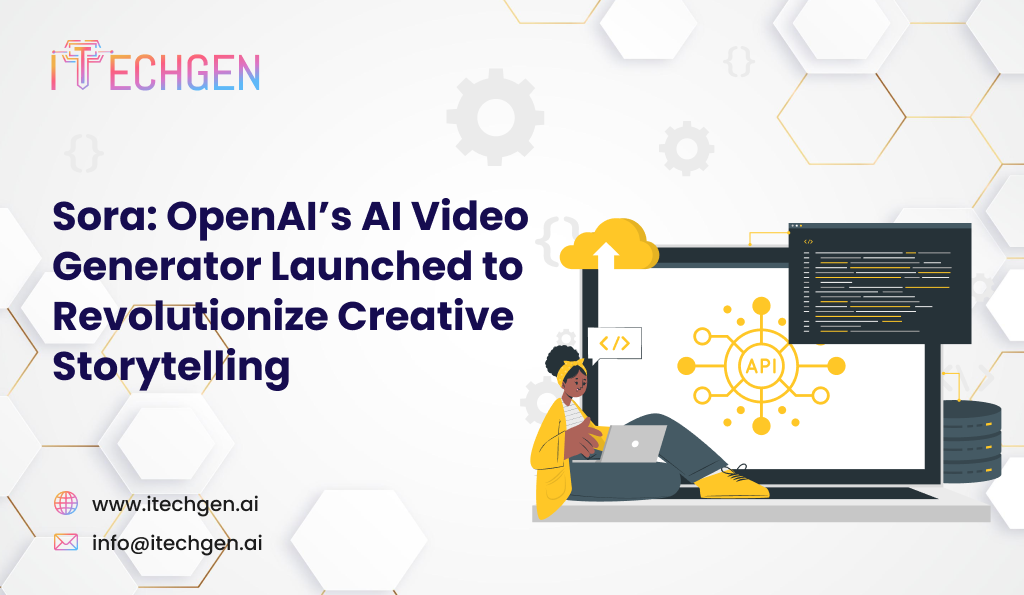
On December 9, 2024, OpenAI launched its groundbreaking AI video generation tool, Sora, marking a milestone moment for artificial intelligence. The tech community has certainly taken notice with early impressions from tech luminaries like YouTuber Marques Brownlee showcasing how this new platform might change content creation—although there are some limitations to it.
This blog will take a look at Sora’s potential, strengths, weaknesses, key features, and technologies, as well as how this innovative tool might help shift the creative landscape.
Sora is OpenAI’s video generation platform that lets you create videos from text, upload images, or edit existing videos. Unlike OpenAI’s widely known ChatGPT, Sora is a stand-alone platform available at Sora.com.
At its core, Sora aims to simplify video creation, enabling users to craft visually compelling content without requiring advanced technical skills. Its capabilities extend to generating unique animations, abstract visuals, and storytelling sequences. The platform also offers tools for organizing and analyzing videos, providing users with access to curated AI-generated clips and the prompts that created them.

Sora lets its users generate videos from descriptive text prompts or uploaded images. Whether creating animations, abstract visuals, or short storytelling clips, Sora makes the process of turning ideas into engaging videos simple. Further, it allows users to customize elements like color schemes, transitions, and styles to match their vision. The AI ensures the final videos are of high quality and suitable for personal or professional use. This feature saves time and effort, making video creation accessible to everyone, even those without design skills.
One of Sora’s standout features is its Re-mix capability, which allows users to make targeted changes to existing videos. With a simple text description, users can instruct Sora to regenerate the video with desired alterations. A “strength” slider provides control over the extent of these changes, from subtle tweaks to bold transformations. The ‘re-mix’ feature is ideal for quick edits, like adjusting colors, replacing backgrounds, or adding effects, without starting from scratch. It also supports maintaining the original style while updating specific details to match user needs.
Maintaining consistency across multiple scenes has been a significant challenge for AI video tools. Sora tackles this issue with its Storyboard feature, allowing users to chain multiple prompts together to create cohesive video sequences. This feature is particularly useful for longer projects or storytelling. Users can adjust each scene while ensuring the overall flow remains intact. The Storyboard tool also supports previewing sequences, making it easier to spot and fix inconsistencies before finalizing the video. Streamlining complex projects saves time and ensures professional-quality results.
Sora offers video resolutions of up to 1080p, catering to a variety of needs. However, higher resolutions require longer processing times. For example, 1080p videos take about eight times longer to generate compared to 480p, while 720p videos take four times longer. Lower resolutions like 480p are ideal for quick previews or situations where speed is a priority. On the other hand, higher resolutions like 1080p are best for presentations or detailed visuals that required clarity.
Sora’s technology is built using some of the latest AI techniques to make it work so well. At its core, Sora uses two key technologies: diffusion models and transformer neural networks. These work together to turn text into engaging, dynamic video content. Understanding how these technologies work explains how Sora can turn simple text prompts into exciting visual stories.
This technological breakthrough is led by diffusion models. It works by slowly turning a random set up of pixels into a clear image or a collection of images, like how an artist will put up a blank canvas. This method helps create highly detailed and contextually accurate visuals from written descriptions. What’s neat about these models is that they can capture the fine details of language, converting abstract concepts into visuals.
Diffusion models start with random noise and gradually refine it by applying learned patterns. This helps in creating the final video where the frame is both original and related to the context.
These models can adapt to many different styles and topics. Hence, they can be used as a decent tool to generate content in different fields.
Alongside diffusion models, transformer neural networks help understand the text prompts that guide the video creation process. These help Sora understand textual prompts by analyzing word relationships. This allows Sora to interpret the intent and context of the prompt, ensuring videos are appealing and meaningful. With Transformers, Sora generates content across various themes and styles.
Sora leverages a mix of machine learning (ML), deep learning, and natural language processing (NLP). These components allow Sora to understand context, generate responses, and improve over time through continuous learning.
Sora is particularly effective at generating creative and visually striking content, such as title slides, abstract animations, and stop-motion-style clips. These features make it an excellent tool for enhancing marketing, educational, or social media content.
Its speed is another advantage. Early testers like Marques Brownlee noted that generating 1080p videos takes only a few minutes, though this may change as the platform scales to accommodate more users.
Despite its potential, Sora isn’t without its flaws. Object permanence remains a notable challenge; objects in generated videos may behave unpredictably, appearing or disappearing in ways that defy logic.
Another issue is rendering movement. For instance, when depicting humans or animals walking, Sora struggles to maintain accurate limb placement, leading to anatomically incorrect motions. These limitations highlight the current challenges in achieving photorealistic results with AI video tools.
As Brownlee observed, “It’s impressive that it’s AI-generated video, but you can tell pretty quickly that it’s AI-generated video.”
Sora marks a significant leap forward in AI-driven content creation. While it currently has its limitations, the platform offers a glimpse into the future of video generation, where creativity is limited only by the user’s imagination.
For businesses, educators, and creators, Sora provides a unique opportunity to produce engaging and innovative video content. As the platform continues to evolve, it will be exciting to see how it transforms workflows and empowers users to bring their ideas to life. The journey for Sora has just begun, but its potential to reshape the world of video creation is already clear. If you’re looking to explore the possibilities of AI-generated video, Sora is certainly a tool to watch.

Pankaj Arora is the Founder & CEO of iTechGen, a visionary leader with a deep passion for AI and technology. With extensive industry experience, he shares expert insights through his blogs, helping businesses harness the power of AI to drive innovation and success. Committed to delivering customer-first solutions, Pankaj emphasizes quality and real-world impact in all his endeavors. When not leading iTechGen, he explores emerging technologies and inspires others with his thought leadership. Follow his blogs for actionable strategies to accelerate your digital transformation and business growth.
View More About Pankaj Arora